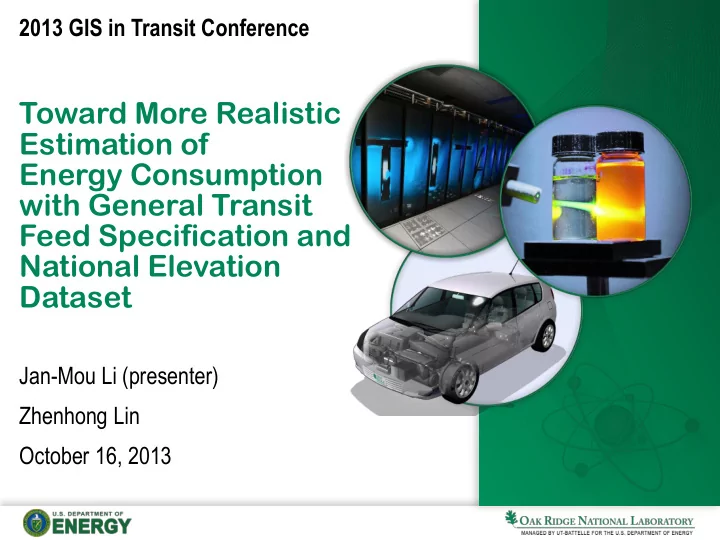

2013 GIS in Transit Conference Toward More Realistic Estimation of Energy Consumption with General Transit Feed Specification and National Elevation Dataset Jan-Mou Li (presenter) Zhenhong Lin October 16, 2013
Introduction • The Challenge – Adoption of Clean, Green Energy for Transit – Provide transit services with • Reducing greenhouse gas emissions • Reducing energy use – Difficulty in accurately measuring energy use and GHG emissions • An energy use measure could be a surrogate for measuring GHG emissions • Estimation of energy use in vehicle operations 2013 GIS in Transit Conference 2
Tractive Demand • Tractive energy and power demand – To make a vehicle travelling – Independent from powertrain configurations • A general form: 𝑄 𝑢 = 𝑛𝐷 𝑆𝑆 𝑑𝑝𝑡𝜒 + 0.5𝜍𝐷 𝐸 𝐵 𝐺 𝑤 2 + 𝑛𝑠∆𝑤 + 𝑛𝑡𝑗𝑜𝜒 𝑤 where P t : average tractive power demand (watts); C RR : tire rolling resistance coefficient; m: vehicle mass (kg); ρ : density of air (kg/m 3 ); g: gravitational constant (9.81 m/s 2 ); C D : drag coefficient; v : average speed (m/s); A F : projected front area (m 2 ); ϕ : road gradient. r : rotational inertia compensation factor; 2013 GIS in Transit Conference 3
Example of the Impact Difference in Tractive Demand Estimation due to Grade 60% 55.55% 50% 47.65% 40% 39.73% Difference 31.80% 30% 23.86% 20% 15.91% 10% 7.96% 0% 0 1 2 3 4 5 6 7 8 Road Grade (%) m: 16783 kg (37000 lb); C RR : 0.006; v : 6.71 m/s (15 mph); ρ : 1.2041 kg/m 3 ; Δ v : 0.89 m/s (2 mph); C D : 0.85; r : 1.3; A F : 6.9 m 2 . 2013 GIS in Transit Conference 4
Example of the Impact (cont’d) Difference in Tractive Demand Estimation due to Grade 120% 104.48% 100% 89.61% 80% 74.72% Difference 60% 59.81% 44.87% 40% 29.92% 20% 14.96% 0% 0 1 2 3 4 5 6 7 8 Road Grade (%) m: 16783 kg (37000 lb); C RR : 0.006; v : 6.71 m/s (15 mph); ρ : 1.2041 kg/m 3 ; Δ v : 0.45 m/s (1 mph); C D : 0.85; r : 1.3; A F : 6.9 m 2 . 2013 GIS in Transit Conference 5
Estimating Road Grades from • Elevation – consistency is the key • GPS devices – altitude error is always worse than the position error • Light detection and ranging (LIDAR) devices – typical absolute accuracies range from 10 to 30 centimeters Source: NOAA Coastal Services Center • National elevation dataset (NED) http://www.csc.noaa.gov/digitalcoast/_/pdf/lidar101.pdf 2013 GIS in Transit Conference 6
National Elevation Dataset (NED) • NED is a seamless product updated bimonthly to incorporate the best available Digital Elevation Model (DEM). • NED is available in spatial resolutions of 1 arc-second (roughly 30 meters), 1/3 arc-second (roughly 10 meters), and 1/9 arc-second (roughly 3 meters). • The most recently published figure of overall absolute vertical accuracy expressed as the root mean square error (RMSE) is 2.44 meters. 2013 GIS in Transit Conference 7
Using NED for Road Grade Estimation • Road grade estimation – Locations along routes – General Transit Feed Specification (GTFS) feeds – Elevation changes • Application programming interfaces (APIs) are available Source: U.S. Geological Survey http://ned.usgs.gov/images/nedus2.gif – USGS Elevation Query Web Service – Make the requests with SOAP, HTTP GET, or HTTP POST 2013 GIS in Transit Conference 8
Data Wanted from a General Transit Feed Specification (GTFS) Feed • agency.txt • stops.txt • routes.txt • trips.txt • stop_times.txt • calendar.txt • calendar_dates.txt • fare_attributes.txt • fare_rules.txt • shapes.txt • frequencies.txt • transfers.txt • feed_info.txt 2013 GIS in Transit Conference 9
Example of Application • Load-based GHG emission estimation – to estimate emissions as a function of engine-load – using a surrogate known as scaled tractive power (STP) – levels of roughness representing the impact of grade on operating loads 2013 GIS in Transit Conference 10
Limitation of the Approach • Natural vs. engineered geographic features – Most, but not all, highway facilities align to terrain e.g. cut and fill sections, bridges, tunnels, and overpass • Post processing of road grade may be required – Based on factors of highway geometric design 694 692 690 NED Elevation (ft) 688 686 684 682 680 678 676 35.96273422,-80.52265167 674 100 200 300 400 500 600 Distance (ft) 2013 GIS in Transit Conference 11
Alternatives of NED • Shuttle Radar Topography Mission (SRTM) – For use with a Geographic Information System (GIS) or other special application software – Available at the US Geological Survey's EROS Data Center • The Google Elevation API – The service will interpolate and return an averaged value using the four nearest locations when Google does not possess exact elevation measurements. – Elevation data for locations and paths – Usage limits • 2,500 requests per day; 512 locations per request; 25,000 total locations per day. 2013 GIS in Transit Conference 12
Conclusion and Recommendation • More realistic estimation of energy consumption for transit operations – Road grade has to be considered • Road grades can be estimated with – NED and GTFS • Post processing of road grade estimation based on NED may be required 2013 GIS in Transit Conference 13
Recommend
More recommend